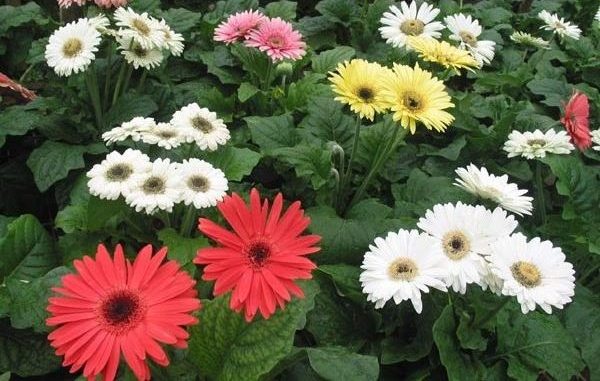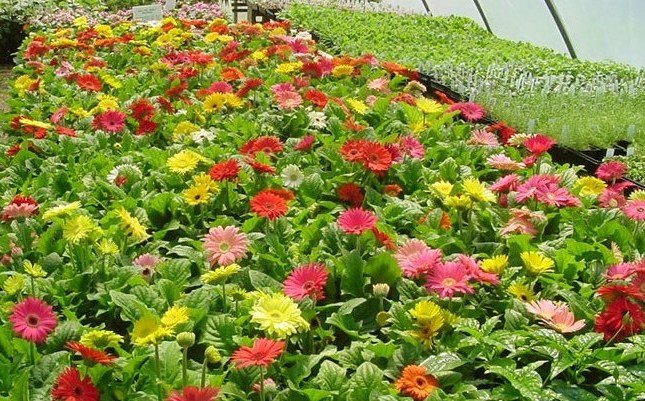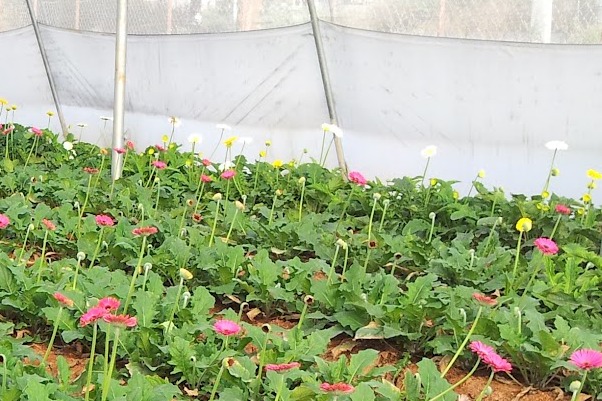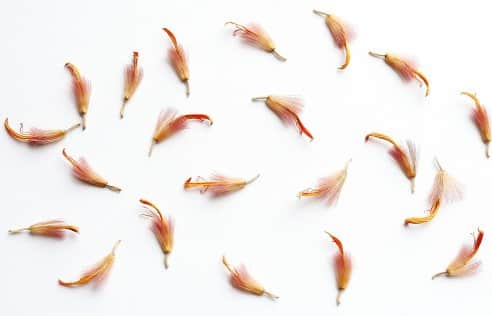Gerbera Flower Farming Guide:
The following information is about Gerbera Flower Farming.

Introduction of Gerbera:- Gerbera is an exotic/ornamental flower plant grown throughout the world and known as “African Daisy” (or) “Transwal Daisy”. This flower originated from Africa and Asian continents and belongs to “Compositae” family. In Indian continent, Gerbera is well distributed from Kashmir to Nepal @ altitudes from 1200 meters to 3000 meters. The freshness and long lasting characteristics of this flower made it to use as decorative flower in parties, functions and flower bouquet. Market commercial value of this flower is excellent in India.
Major Gerbera Cut Flower Production States in India:- West Bengal, Maharashtra, Andhra Pradesh, Orissa, Karnataka, Gujarat, Uttar Pradesh, Uttaranchal and Arunachal Pradesh.
High Yielding Hybrid Varieties of Gerbera in India:-
- Red coloured : Ruby Red,Dusty, Shania, Salvadore,Tamara, Fredorella, Vesta & Red Impulse.
- Yellow coloured : Supernova,Nadja, Doni, Mammut,Uranus, Fredking,Fullmoon, Talasa & Panama.
- Orange coloured : Kozak,Carrera, Marasol, Orange Classic & Goliath.
- Rose Coloured : Rosalin & Salvadore.
- Cream Coloured : Farida, Dalma, Snow Flake & Winter Queen.
- White coloured : Delphi & White Maria.
- Purple coloured : Treasure & BlackJack.
- Pink coloured : Terraqueen,Pink Elegance, Esmara,Valentine & Marmara.
Climate Required for Gerbera Flower Farming:- Gerbera flowers can be grown in both tropical and subtropical climatic conditions. These flowers can be cultivated in open fields under tropical climatic conditions. As these flowers are sensitive to frost conditions, they are cultivated in greenhouse/shade net house under subtropical/temperate climatic conditions. Optimal day temperatures of 20°C–25°C and nightly temperature of 12°C-15°C is ideal for Gerbera cultivation.

Soil Requirement in Gerbera Flower Farming:- The soil should be well drained, light, fertile/rich, slightly alkaline (or) neutral in nature. The pH range of 5.5 to 6.5 is best suitable for Gerbera cultivation. As the roots of Gerbera plant penetrates deep into soil (up to 60 cm), the soil should be porus and should have good internal drainage (up to 50 cm deep) for optimal growth of roots.
Land Preparation in Gerbera Flower Farming:- Bring the soil to a fine tilth by ploughing 3 times with tractor or country plough. Prepare the beds of 30 cm height, 1.0 meter to 1.5 meter width and leaving the space of 35 cm – 50 cm between beds. Add well rotten Farm Yard Manure (F.M.Y), sand and paddy husk in 2:1:1 proportion to the prepared beds.

Soil Sterilization in Gerbera Flower Farming:- To save the crop from soil borne diseases, soil disinfection must be carried out well before gerbera cultivation. There are three main soil borne pathogens like Fusarium, Phytophthora and Pythium which would destroy the entire crop if the soil disinfection is not done. The prepared soil beds should be fumigated with Methyl Bromide (30 grams/square meter area) solution (or) 2% of formaldehyde (100 ml Formalin in 5 liter of water/square meter area) solution or Methyl Bromide (30 grams/square meter area) solution. Cover the fumigated beds with a plastic sheet for a minimum period of 3 to 4 days. To drain out the chemicals from the beds, watering should be done.
Planting Season in Gerbera Flower Farming:- Gerbera plantation can be done in spring as well as summer season. Gerbera needs good light intensity, planting in spring season (Jan to March) is best for 1.5 year tissue culture. Summer (June to July) is Suitable for 1, 1.5 & 2 years tissue cultures. Planting in autumn and winter (November and December) is not recommended due to low light intensity and high heating cost. Planting should be avoided in late August or September as it has to sustain in winter season.
Propagation in Gerbera Flower Farming:- Gerbera plants commercially propagated through suckers & tissue culture.
Division and Micro-Propagation are the two propagation methods used in Gerbera cultivation.
- Division:– In this method, propagation is done through division of clumps in June – July month and this most commonly used method.
- Micro-propagation: – This method is gaining popularity day by day for fast and large scale production. In this methods, flower heads , shoots tips, flower buds, inflorescence, capitulum & mid ribs are used as ex-plants.

Planting Method in Gerbera Flower Farming:-
Planting Method in Gerbera Farming: – Raising gerberas in bed improves air circulation (Aeration) & drainage. Keep the crown of gerbera plants 1 to 2 cm above the soil level at the time of planting as the root system establishes deep in soil and pulls down from the ground level.
Spacing in Gerbera Flower Farming:- Spacing of 25-30 cm within the row & 30-40 cm between the rows should be maintained to accommodate 7 to 10 plants/square meter.
Manures and Fertilizers in Gerbera Flower Farming:- In order to have better growth and excellent yield of Gerbera flowers, field/soil should be incorporated with plenty of organic manure and other major, minor nutrients. Following is the manures and fertilization schedule in Gerbera cultivation.
- Apply 8 to 9 kg of Farm Yard Manure (FYM)/square meter.
- Apply NPK in 12:15:20 grams/square meter during first three months after plantation.
- Apply NPK in 15:10:30 grams /square/month from fourth month when flowering starts, apply in two split doses @ 2 weeks interval.
- Apply micro-nutrients: Spray calcium, boron, copper & magnesium @ 0.15 percent, which is 1.5 grams/liter of water once in 4 weeks gives excellent quality Gerbera flowers.
Irrigation in Gerbera Flower Farming:- Immediate Irrigation is required after planting and continue to irrigate for a month to enable a good root establishment. Thereafter, drip irrigation should be done once in 2 days @ 4 liter/drip/plant for 15 minutes. An average requirement of water is up to 700 ml/day/plant.
Weed Control in Gerbera Flower Farming:- Weed control is an important operation in Gerbera cultivation and should be carried once in 2 weeks for 3 first months of plantation. After 3 months, Subsequent weeding should be done @ 30 day interval. Hand weeding should be done whenever required.
Follow these basic weeding operations.
- Remove the Gerbera flower buds up to 8 weeks (2 months) & then allow for flowering.
- For easy absorption of water, fertilizer and providing air circulation to the roots, rake the soil once in 2 weeks.
- Always remove older leaves for allowing new leaf growth.
Pests and Diseases in Gerbera Flower Farming:-
Main pests found in Gerbera plantation are as follows:
- Aphids: To control this, spray Dimethoate 30 EC @ 2 ml/liter of water.
- Thrips : To control this, spray Dimethoate 30 EC @ 2 ml/liter of water.
- Whitefly: To control this, spray Dimethoate 30 EC @ 2 ml/liter of water.
- Red spider mite: To control this, spray Abamectin 1.9 EC @ 0.4 ml/liter of water.
- Nematode: To control this, apply Pseudomonasfluorescens @ 2.5 kg/hectare in soil at the time of planting.
Main Diseases found in Gerbera plantation are as follows:
- Flower bud rot: To control this, spray copper oxychloride @ 2 grams/liter of water.
- Powdery mildew: To control this, spray Azoxystrobin @ 1gram/liter of water.
Harvesting of Gerbera:- Normally, Gerbera plants starts flowering in about 3 months after planting. Harvesting is done, when flowers completely open or when outer 2 to 3 rows of disc florets are perpendicular to the stalk. To improve the flower life, Flower stalk should be soaked in solution of Sodium hypochloritde (6 to 7 ml/liter of water) for about 5 hours.
Post Harvesting Tasks in Gerbera Flower Farming:- The heel for the stalk has to be cut about 2 to 3 cm above the base and keep in fresh chlorinated water. Flowers should be sorted out and graded for uniformity and packed in carton boxes.
Yield of Gerbera:- Any crop yield depends on the farm management practices and variety and soil type.
In Gerbera cultivation, following is the average yield in open and greenhouse cultivation.
- Under open field/shade net cultivation: 140 to 150 cut flowers/square meter/year can be expected.
- Under Greenhouse cultivation: 225 to 250 cut flowers/square meter/year can be obtained.
Bottom Line of Gerbera Flower Farming:- It is one of the best profitable cultivation crop, which has very good commercial value across India and local markets.
To find out Goat or Sheep Farming Info in India: Read Here.
I want to start Gerbera flower farming in polyhouse. How to start this Polyhouse farming?. How can we market these flowers?. Is it a potential flower to start up a in a polyhouse?
Growing Gerbera flowers in the polyhouse is an excellent option. It fetches decent profits with right marketing. You can tie up with event management companies who can decorate marriage halls, Parties, functions. Apart from that you can sell them in the local flower market. It is a good idea to have a contract farming agreement with event organizers. You can get up to 80% of subsidy to set up a polyhouse/greenhouse.Gerbera flowers are expensive and have excellent demand in India.
You can read: POLYHOUSE SUBSIDY.
We will soon update Polyhouse Gerbera Farming Project Report.
Hi Team,
I would like to start Gerbera flower farming (in Polyhouse) in Andhra Pradesh near Kakinada. Is it the right place to start Gerbera flowers, farming there, my land is red soil?. Need advice & guidelines in this. Your response is much appreciated.
Yes, Gerbera has excellent demand and expensive as well. It is right, cut flower crop for controlled environment like polyhouse and greenhouse.
I am having 1 acre shednet, I want to grow Gerbera in shednet, whether it is feasible, please reply.
They are the best flowers for polyhouse/greenhouse rather shadenet.
I want to know market about Gerbera flower. I want to farm it in Polyhouse in Nadia district, West Bengal. So I need to know where I can sell the flowers and how the transactions take place, prices, transport, wholesale buys contact, how prices vary over the year etc. Can someone guide me on that?
Gerbera flowers have excellent demand. You can easily market if you get hold of any event management people. We will be updating soon about Gerabera Farming.
Hi sir,
Myself Prof. Naveen K B from Tumkur, Karnataka and i am planning to grow Gerbera cultivation in my 2 acres land which is very near to hill. I want to learn something about it. Is it possible to meet you once to learn about this?
Hi sir, I want to farm gerbera in kadapa district. Is it suitable if I go for polyhouse. What should be the temperature if I want to farm and is it good in our town for farming.
Hi , i want to do farming of gerbera in davanagere district, please give some idea.
I wnt ti know contract farming about gerbera flower
The information provided is very educative and detail. I am interested in gerbera cultivation. Is it advisable to plant in open field or does it require poly house. I would also like to know the source of largescale plants for plantation.
Regards.